A dog’s behavior when he grows is directly proportional to obedience training it received during the puppyhood. You should start the Dog Obedience Training early because the puppy has not learned the Bad Habits at this stage and teaching Good Habits first hand is the easy way to do it.
In this article, we are going to share everything you need to know about obedience training for dogs and you will leave equipped with skills to help your puppy behave well.
The most vital part is teaching the skills your dog needs to be a good listener and follow your directions.
Basically, obedience training is an education in good manners.
In our relationship with our dog focus plays a huge role!
The more your dog enjoys the interaction and play, the more willing they will be to listen to you.
We are huge believers in making use of your dog’s favorite toy as a training tool!
Table of Contents
Obedience Trainer
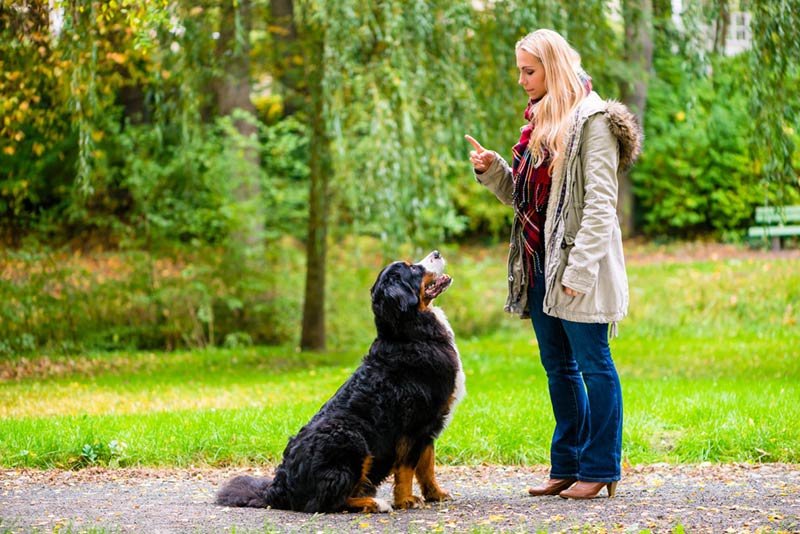
When looking for an Obedience trainer, research his or her certifications, education and experience and if possible ask for references as well.
Dog trainers use various techniques to help dogs improve their obedience, behavior, and performance.
Dog trainers are equipped to handle symptoms, but not necessarily the underlying causes of the symptoms.
Dog trainers are of great help when it comes to helping “out of control” dogs become polite and well mannered.
Obedience trainers specialize in behavior modification, problem-solving and obedience training.
Trainers help to solve various behavior problems such as:
- Housebreaking
- Pulling on the leash
- Not coming when called
- Darting out through open doors
- Hyperactivity
- Destructiveness
- Aggression
- Nipping & mouthing
- Fear
- Jumping on people
- Excessive barking
- Counter surfing
Dog Obedience Tips
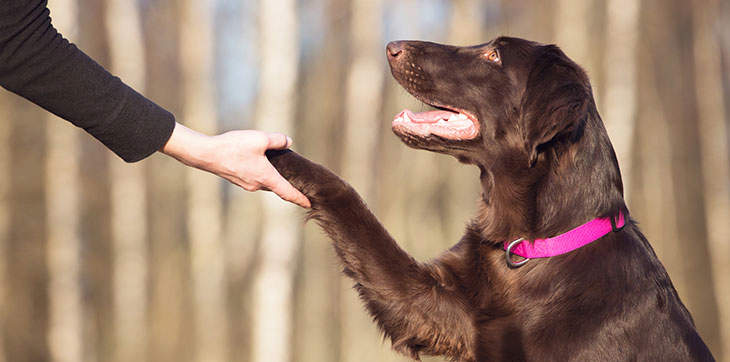
No one likes an unruly, impolite, and undisciplined dog.
Obedience training is essential for your dog.
Also, the fact is dogs are much happier when they have boundaries and know what’s expected of them.
If you’ve never obedience trained a dog before, you might consider joining an obedience class but trust me it’s no rocket science.
If you decide to try your hand at it and the simpler you make it, the more success you’ll see.
- Assigning consequences to behavior.
- Understand how dogs learn.
- Don’t consider violence, it instills fear in your dog.
- Keep the command short and consistent.
- Keep the consequences consistent as well.
- Focus on teaching specific skills.
- Keep the training sessions short.
- Be a firm but a loving leader.
- Lots of practice and patience.
- Know your breed.
When To Start Training?
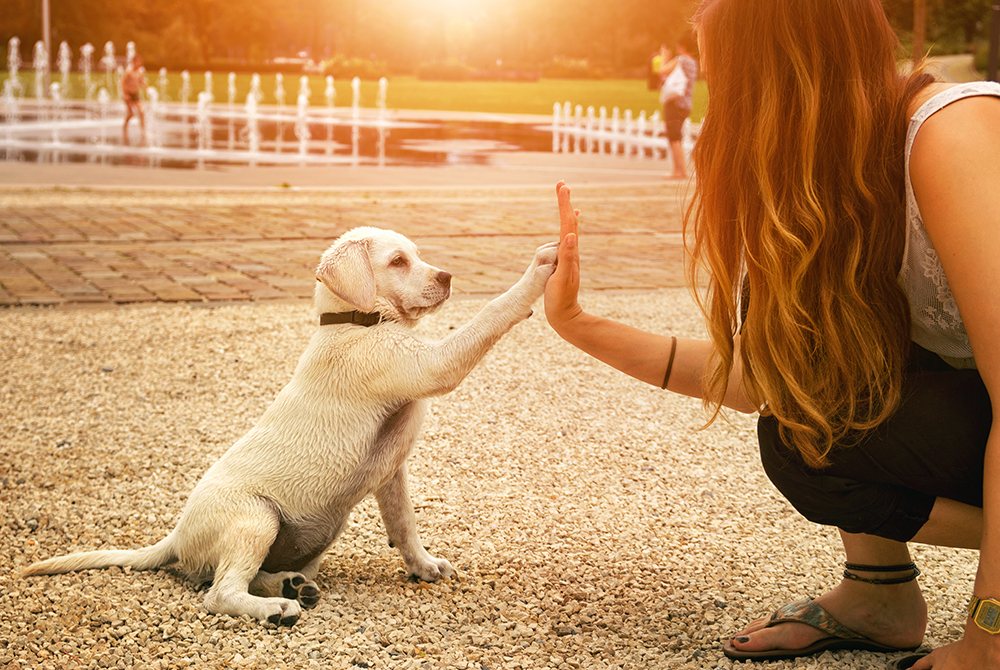
The sooner, the better it is!
It’s easier to train a puppy how to act obediently than to retrain an adult dog who may have already established less-than-ideal behaviors.
Similarly, how every individual is different from each other, every dog is also different.
Some are laid-back whereas some are hyperactive and while some are serious and others are silly.
Regardless of these differences, training is necessary for all dogs and highly beneficial to your entire family.
Dog Obedience Training Cost

The cost of dog obedience training has various categories; group classes are less expensive than private sessions with professional trainers.
Few group classes include basic puppy training, obedience classes for adult dogs, “growly” classes for dogs dealing with anxiety or aggression and also a session of class that teaches pets new tricks or skills like scent work.
The average cost of dog training ranges from $30 to $80 per hour, costing about $240 to $600 for six sessions.
The cost of private dog training depends on the breed, age, and size of the dog; the location of the dog training sessions; and the level of habit adjustment needed also.
The goal of personal dog obedience training can go far beyond basic commands like sit, lie down or stand.
Private training can also help with separation anxiety, barking, chewing, digging, socialization with other dogs and people, and biting.
A good trainer will observe every detail about the dog, the dog’s interactions with each member of the family and train him or her to respect them all.
Obedience Training for Puppies

Puppies have short attention spans.
What is the appropriate age to start training my new puppy?
This question might be in your head but let me help you with that.
There is no ideal age for the initial training of a puppy but puppy training is the first step to teaching healthy behaviors and avoiding negative ones.
Formal dog training has traditionally been delayed until 6 months of age because this juvenile stage is a very poor time to start.
Puppies can be taught to “sit,” “down,” “stand,” and “up” using the food-lure training method.
Dog Training Techniques
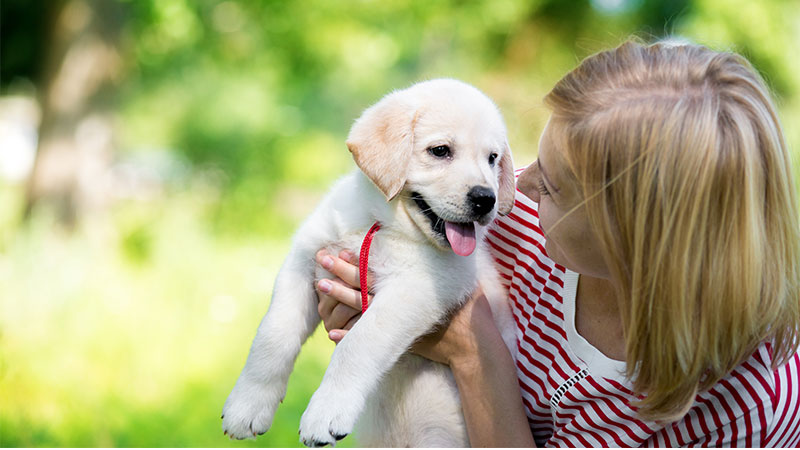
What according to you is the best way to train a dog?
There are various dog training techniques that you can try to train your dog.
Patience and a basic understanding of canine behavior can help you raise a well-behaved pet who might even surprise you with a few tricks.
There are many factors that play a vital role in choosing the right trainer or training school for you and your dog.
Training a dog in the right way comes with benefits as well as rewards for both dog and owner.
1. Positive Reinforcement
It is a part of modern dog training techniques and is more effective and enriching, as compared to traditional dog training methods like ones that use punishment and intimidation to modify dog behavior.
Let me tell you how Positive reinforcement works, it helps your dog associate obedience with positive rewards.
It is more likely that if good behavior is rewarded, the more frequently and easily the dog will perform said behavior.
Don’t you feel that we can be better trainers if we understand how those ‘laws’ are influencing our behavior?
2. Reading Your Puppy’s Body Language

Body language has been a medium for dogs to communicate with each other.
This involves facial expressions, body postures, noises, and scents.
A dog uses their mouth, eyes, ears, and tail to express emotions.
By gaining knowledge about how to interpret your puppy’s body language, you can interpret your puppy’s intentions.
Signs Of Aggression Or Submission

When your puppy feels brave or aggressive, he’ll try to make himself larger by standing tall, with his ears and tail sticking upright.
He’ll raise the hair on his neck and back and he might also growl and wave his tail slowly.
On the other hand, a submissive dog will try to make himself appear petite and act like a puppy and this is because an adult dog will “tell off” a puppy but not attack him.
The submissive behavior of dogs will take the form of a sideways crouch near to the ground, his tail held low but wagging away.
He may also try to lick the face of the dominant dog or human and might as well roll on his back.
Leash Training For Dogs and Puppies
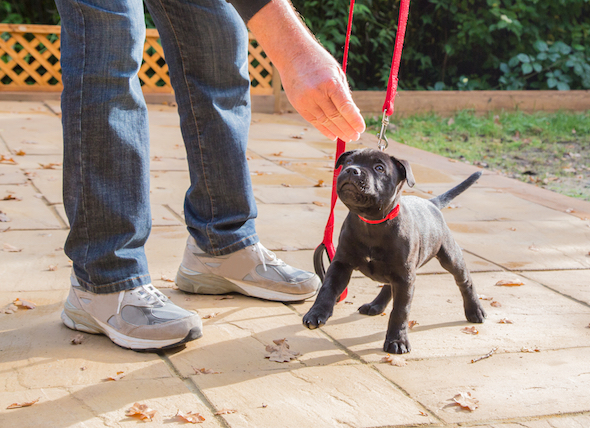
Every dog should learn to walk with a leash on.
Besides the fact that most places have leash laws, there will be times when keeping your dog on a leash is for his own safety.
Learn how to introduce your dog or puppy to the leash, then teach him how to walk properly on the leash because it’s something very new to them.
A loose leash walk teaches your dog not to pull or lunge when on the leash, making the experience more enjoyable for your dog and yourself.
Dog Training Command-List
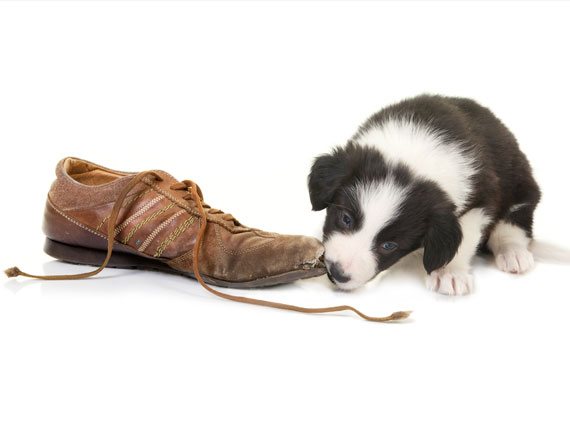
Ever wondered to have a well-trained dog?
Dog Obedience Training is arguably the most valuable training you can do with your dog, an amazingly trained dog is not the same as having a balanced dog.
These commands are impressive to use and may also offer additional mental and physical stimulation to your canine as they learn more things.
To know more about dog training commands click here basic dog training commands your dog should know.
1. SIT
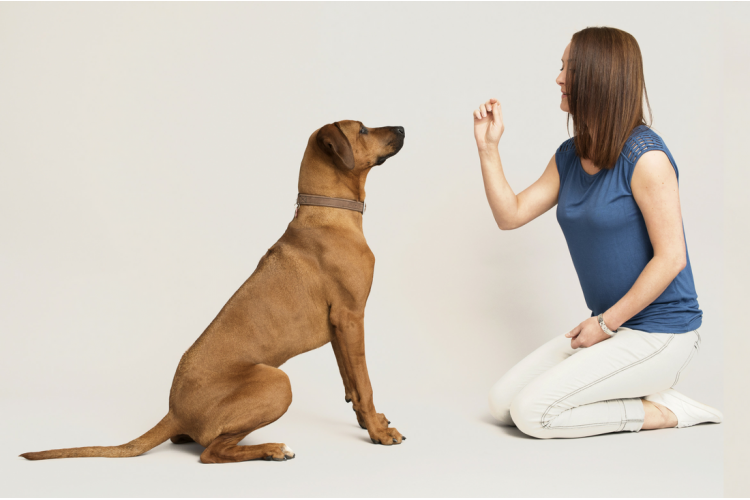
Let’s begin with this one first:
This is considered to be one of the easiest of the dog obedience commands to teach.
- Firstly hold a treat close to your dog’s nose.
- Move your hand up and sideways, so that he follows the treat and moves his head up in the same direction, which will cause his bottom to lower.
- Once he sits, say “sit” and then give the treat to appreciate this habit.
Repeat this several times each day until your dog has learned it well.
2. COME
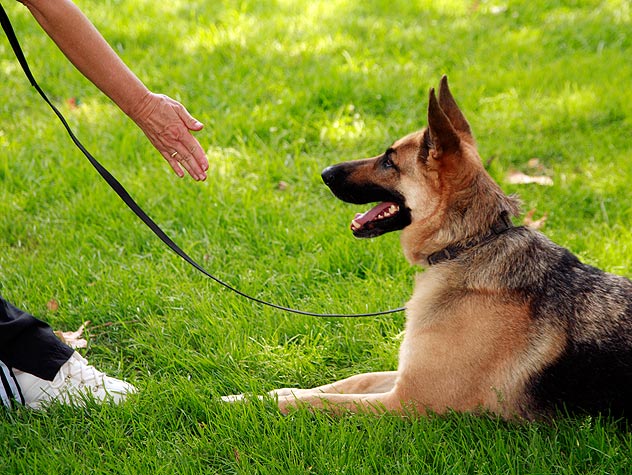
This command assists in bringing your dog back to you if you accidentally lose the grip of the leash or leave the front door open.
- Put a leash and collar on your dog.
- “Come” while gently pulling on the leash.
- When he moves towards you, reward him with the treat and appreciate him.
- Once he is mastered with the leash, remove it and practice the command without it in a safe and closed place.
3. DOWN

The most difficult command in dog obedience training because the position is a submissive posture.
- Firstly, find a treatment that has a pleasant smell and holds it in your closed fist.
- Hold your hand up to your dog’s snout.
(When he sniffs it, move your hand to the floor, so that he follows it.)
- Then slide your hand along the ground in front of him to encourage his body to support his head.
In case your dog lunges towards your hand, say “NO” and take your hand away from it.
Once he is in the down position, say “down” then give him treat and applause.
4. STAY
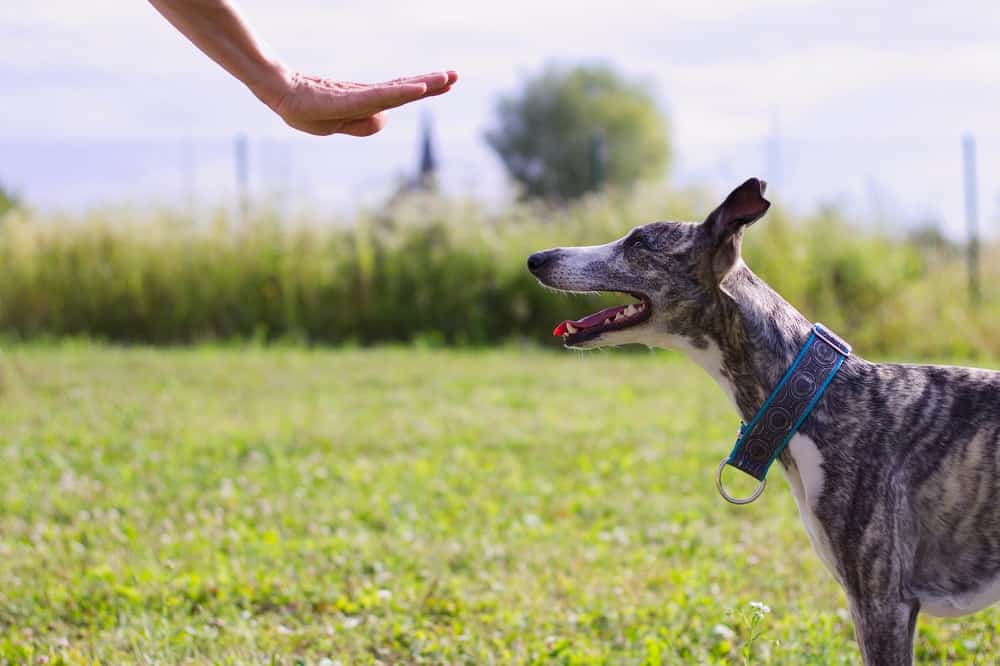
Before jumping on this step, make sure that your dog is an expert at the “sit” command.
- First, you have to ask your dog to “sit.”
- Then open the palm the one with the treat and show it to him, say “stay”.
- Take a few steps backward and reward him with treat and affection if he stays.
- Finally, increase the number of actions and always pay your pup for staying, even if it is just for a few seconds.
This helps in dog’s self-control so don’t feel demotivated if your dog takes time to master it.
5. NO
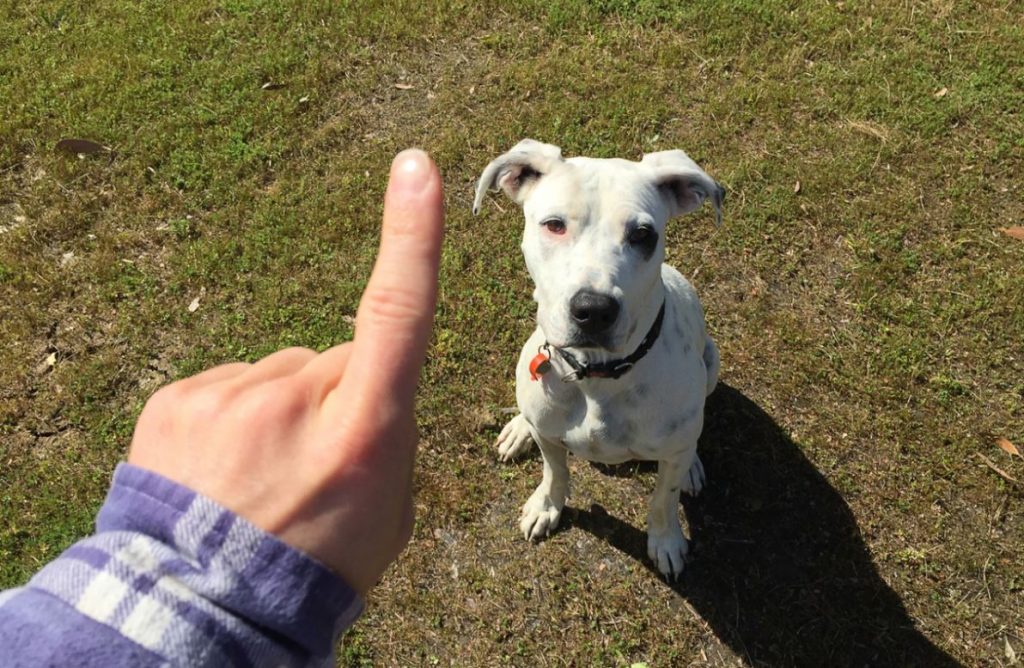
Another essential dog command that your dog must learn is “No”.
However, most dogs simply learn “no” from your tone and facial expression without any formal training.
If you’re facing trouble with teaching “no” this way, tugging on your dog’s leash and forbidding him from performing the action you want to stop might also work.
Different Ways of Giving Commands
1. Use Hand Signals

Did you know your dog is more of a visual learner?
You may want to incorporate certain simple hand signals to go with every command.
Additionally, using hand signals with your dog to communicate your thoughts to him will increase your bond with him.
Make a note that you should be consistent since this is another language you and your dog are learning together.
Also, don’t forget to reward your canine buddy when they perform pleasantly.
2. Use Verbal Cues
Do you stay in a noisy household?
If your dog hears talking all day long, how will he know you are giving him commands underneath all the blah-blah-blah around?
Try issuing commands in another language, but of course, this is more effective if the language is not commonly spoken around them.
Final Thoughts

Training your dog to follow commands helps both you and your dog to live a happy life together 🙂
The whole process of training and achieving different levels of command may increase the bond with your pet, as well as give them a better sense of well-being.
In addition, training doesn’t have to stop once you master the basic commands.
Continue working through the dog training commands list.
It is a hassle-free process you don’t have to take your dog into training classes when you plan to upgrade levels of commands they understand and follow.
This was all about obedience training in puppies and adult dogs.
Give your thoughts down in the comment section.
Stay with us to know more about dogs and different breeds!
Happy Petting To You Guys!



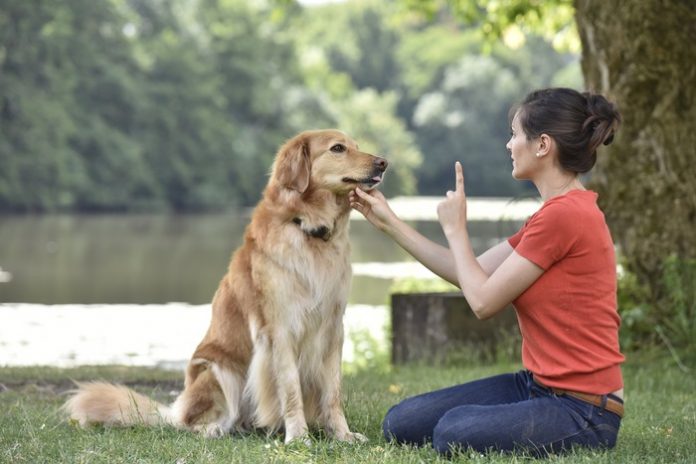









[…] Obedience Training is very important for dogs. […]
[…] To read about Dog Obedience Training, click here. […]
[…] is an article on Dog Obedience Training for further […]
[…] terrier can be a strain at times as it is averagely intelligent. But a Tibetan terrier always obeys what their master tells them to. They are disciplined and try to learn things […]
[…] While training and socializing are a must for GSDs, make sure you use good ways of training like – Positive Reinforcements, Clicker Training, or Relationship Based Training. Never punish your dog for incorrect behavior by getting physical with him, treat him like your own baby, and then see from the shoes of a father. You may not give a treat, make use of NO or 100 other ways to train clean. […]
[…] SportDOG Brand 425X Remote Trainers – 500 Yard Range E-Collar can train up to 3 dogs at a time. The remote-control device will be the same but you will have to buy more […]
[…] of strangers and control their strong preying instincts. They are the smartest when it comes to obedience training. […]
[…] of strangers and control their strong preying instincts. They are the smartest when it comes to obedience training. […]
[…] WhatsApp Telegram Facebook Twitter Pinterest Previous articleDog Obedience TrainingNext articleWhy Do Dogs Chase Their Tails? ShifaShe is Shifa, one of our content writers. She loves […]
[…] a command 85% of the time and can learn a new command in just 5-15 repetitions. A little bit of obedience training you can make use of your Mini Schnauzer’s […]
Really nice post Harshita
After reading your post I also tried to write an article on this topic please check out
[…] Collie is highly trainable. With proper obedience training, you can control every movement of your dog. They will not only listen to your commands but also […]
Hello, everything is going perfectly here and ofcourse every one is sharing information, that’s in fact fine,
keep up writing.
I need to have my Goldendoodle to stop jumping on me. Also very aggressive when she has something she
shouldn’t have shows her teeth and growls and jumps at me. She will be 6 months old on the 11th. This behavior must stop. Can you help?
[…] Dog Obedience Training […]